Star blows giant exoplanet's atmosphere away, leaving massive tail in its wake
The explosive process happening 950 light-years from Earth and is creating a huge tail of gas that is one of the largest structures seen around a planet outside of the solar system.

A planet located 950 light years from Earth is explosively losing its atmosphere and creating a tail that is around 18 times the size of Jupiter in the process. This makes the gaseous tail one of the largest planetary structures seen outside the solar system.
The extra-solar planet, or exoplanet, known as HAT-P-32 b has a mass around 68% that of Jupiter but is twice as wide as the solar system's largest planet. HAT-P-32 exists just 3.2 million miles from its parent star, or about 3% of the distance between Earth and the sun, and completes an orbit every 2.2 days. This proximity means the gas giant is roasted by radiation from its parent star, classifying HAT-P-32 b as a "hot Jupiter" planet.
Astronomers have monitored the trailing gas tail of HAT-P-32 b created from helium flowing from its atmosphere with telescopes from Earth, including the Hobby-Eberly Telescope of The University of Texas at Austin's McDonald Observatory. "We have monitored this planet and the host star with long time series spectroscopy, observations made of the star and planet over a couple of nights," research lead author and University of California Santa Cruz, Department of Astronomy and Astrophysics postdoctoral fellow Zhoujian Zhang said in a statement. "And what we found is there's a gigantic helium gas tail that is associated with the planet. The tail is large — about 53 times the planet's radius — formed by gas that's escaping from the planet."
By learning more about how this hot Jupiter is losing its atmosphere, a team of researchers hopes to build a better picture of planetary evolution. This could help solve a puzzling absence of a specific planetary type in the exoplanet catalog.
Related: New 'warm Jupiter' exoplanet has a weird orbit and another planet may be to blame
Using a hot Jupiter to investigate the "hot-Neptunian desert"
Since the first planets outside the solar system were first discovered in the 1990s, exoplanet hunters have found over 5,000 worlds orbiting distant stars, and these come in an array of shapes, masses, and characteristics. Yet there remains a puzzling gap in our exoplanet catalog.
Astronomers have discovered a vast array of large Jupiter-sized planets orbiting close to their stars and fewer, but still a considerable number of small Earth-sized worlds proximate to their stellar parents.
Get the Space.com Newsletter
Breaking space news, the latest updates on rocket launches, skywatching events and more!
What seems to be missing, however, are intermediate-sized planets orbiting close to their parent stars. Astronomers refer to such planets as "hot-Neptunes" after the solar system ice giant of a similar size, and thus, the absence of these worlds is called the "hot-Neptunian desert."
One of the possible explanations for this absence is that planets close to their stars are being stripped of their atmosphere and are thus losing mass.

"If we can capture planets in the process of losing their atmosphere, then we can study how fast the planet is losing its mass and what are the mechanisms that cause their atmosphere to escape from the planet," Zhang explained. "It's good to have some examples to see, like the HAT-P-32 b process in action."
The team studied HAT-P-32 b, which was discovered in 2011, by observing light coming from its parent star, which is around the same size as the sun and is slightly hotter than our star. When the hot Jupiter passes in front of the star, starlight is filtered through the planet's atmosphere.
Because chemical elements absorb light at specific frequencies, astronomers can compare starlight that has filtered through the atmosphere to starlight that hasn't, helping them determine the chemical composition of the planet's atmosphere. Searching for these absorption gaps is called "transmission spectroscopy."
Performing transmission spectroscopy for HAT-P-32 b revealed deep helium absorption lines in starlight when the planet transited the star.
"The helium absorption is stronger than what we expect from the stellar atmosphere. This excess helium absorption should be caused by the planet's atmosphere," Zhang said. "When the planet is transiting, its atmosphere is so huge that it blocks part of the atmosphere that absorbs the helium line, and that causes this excess absorption. That's how we discovered the HAT-P-32 b to be an interesting planet."
But, to better understand it, they created a 3D simulation of this hot Jupiter using the Stampede2 supercomputer of the Texas Advanced Computing Center (TACC). And the computer modeling of the planet revealed it to be even more interesting than even these observations had suggested.
The computer simulations developed by the Harvard-Smithsonian Center for Astrophysics Institute for Theory and Computation researcher Morgan MacLeod, and colleagues modeled the interaction between the outflow of gas from the planet and stellar winds from its parent star.
This showed that planetary outflow was both trailing and leading HAT-P-32 b in its orbital path.
The team was also able to calculate the rate of mass loss for the planet, finding that it would take 40 billion years for HAT-P-32 b to completely lose its atmosphere. The planet is unlikely to survive this long, however; F-type stars like the planet's host star HAT-P-32 A only have lifetimes of between 2 to 4 billion years, after which they exhaust the hydrogen at their cores used for nuclear fusion.
This causes the star's core to collapse and the outer layers where nuclear fusion is still ongoing to swell out. This increases the star's radius up to a hundred times, resulting in the creation of a red giant. When HAT-P-32 A undergoes this process, the exoplanet is so close to it, that it and its remaining atmosphere are likely to be engulfed.
In the future, the team intends to study other planets similar to HAT-P-32 b to observe their evolution. Additionally, the researchers behind the supercomputer model will now develop other sophisticated simulations for exoplanet dynamics.
This could deliver simulations that can model other effects like the mixing of gas gases in planetary atmospheres and even how the winds move through atmospheres for planets hundreds or even thousands of light-years from Earth, too far for these effects to be observed with current telescopes.
"Now is the time to have supercomputers with the computational power to make this happen," Zhang concluded. "We need the computers to make real predictions based on recent advances in the theory and to explain the data. Supercomputers bridge the model and the data."
The team's research is published in the journal Science Advances.
Join our Space Forums to keep talking space on the latest missions, night sky and more! And if you have a news tip, correction or comment, let us know at: community@space.com.

Robert Lea is a science journalist in the U.K. whose articles have been published in Physics World, New Scientist, Astronomy Magazine, All About Space, Newsweek and ZME Science. He also writes about science communication for Elsevier and the European Journal of Physics. Rob holds a bachelor of science degree in physics and astronomy from the U.K.’s Open University. Follow him on Twitter @sciencef1rst.
-
rod "The extra-solar planet, or exoplanet, known as HAT-P-32 b has a mass around 68% that of Jupiter but is twice as wide as the solar system's largest planet. HAT-P-32 exists just 3.2 million miles from its parent star, or about 3% of the distance between Earth and the sun, and completes an orbit every 2.2 days. This proximity means the gas giant is roasted by radiation from its parent star, classifying HAT-P-32 b as a "hot Jupiter" planet."Reply
There are 1686 exoplanets moving around their stars < 0.1 au distance. Many more will be roasted too. http://exoplanet.eu/
Astronomy finds an abundance of exoplanets, very different than our Earth with life teeming on it. -
rod 238 of the 383 listed TESS exoplanets orbit 0.1 au or closer as well. https://exoplanetarchive.ipac.caltech.edu/index.htmlReply -
billslugg HAT-P-32 has 1.2 x the Sun's mass, 1.4 times its radius. Temperature is 6000K vs Sun at 5772K. Planet's distance is 0.0344 AU.Reply
Heat flow varies by the 4th power of temperature delta, inverse 2nd power of distance. Insolation to this planet is thus (1/0.0344)^2 x (6000/5772)^4.
I get 845 times just due to distance. Another 16% due to temperature. Take extra sunscreen.








